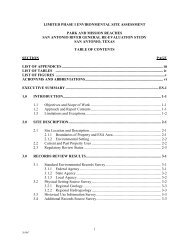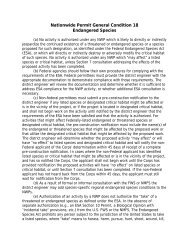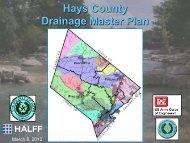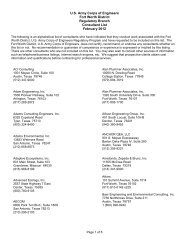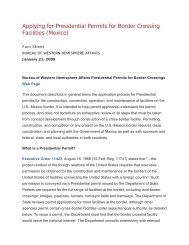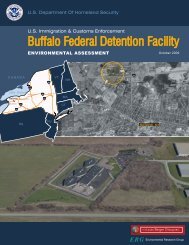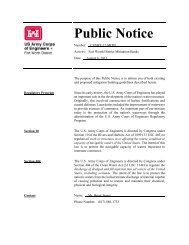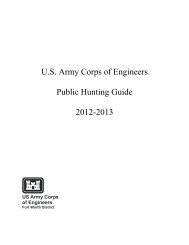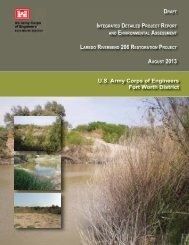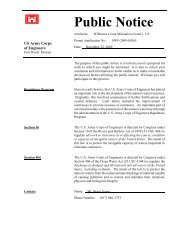environmental assessment us border patrol, tucson sector
environmental assessment us border patrol, tucson sector
environmental assessment us border patrol, tucson sector
Create successful ePaper yourself
Turn your PDF publications into a flip-book with our unique Google optimized e-Paper software.
3-291234567891011121314151617181920212223242526272829303132333435363738394041424344454647distinctive projectile point styles during these periods (Huckell 1995). The San Pedro phase isnamed after several sites in the upper portion of the San Pedro drainage to the west.Late Archaic period subsistence was once thought to have been based on wild plant gatheringand small-game hunting, supplemented by limited agriculture in later time periods, andsettlements were believed to have been occupied seasonally or semi-permanently, depending onthe availability of wild plant and animal resources. However, current evidence indicates thatagriculture was introduced from Mexico into the North American southwest by at least 1500 to1000 B.C. (Huckell 1995). Corn, squash, beans, and possibly tobacco, appear to have beenadopted as a crop complex that spread rapidly.Pre-Classic PeriodThe current project area is located in a cultural <strong>border</strong>land between the Hohokam to thenorthwest, the Mogollon to the northeast, and the Casas Grandes sphere to the southeast. Siteswithin this region typically display a suite of traits from each of the major cultural areas.Although ceramic figurines and miniature pots were made in southern Arizona during the EarlyAgricultural period, pottery vessels large enough to be <strong>us</strong>ed for practical purposes did notbecome common until after A.D. 150 (Mabry 1998). The widespread appearance of pottery inthe San Pedro River Valley is associated with the emergence of the Hohokam and Mogolloncultural traditions. The area north of Benson is believed to have been farmed by Hohokamimmigrants from the Phoenix Basin (Doelle and Clark 2003). The area south of Benson appearsto be more closely affiliated with Mogollon groups to the east. Corn, beans, squash, and cottonwere the main crops grown by prehistoric populations in the region, and a variety of native plantswere harvested from the surrounding countryside, including agave, cact<strong>us</strong> fruit, and mesquitebeans. Jackrabbits, cottontail rabbits, and other small game animals were the primary sources ofmeat, and deer, antelope, and bighorn sheep were also hunted on occasion.Archaeologists have subdivided the Hohokam Pre-Classic period into three broad time units. Theearliest of these is the Pioneer period, which lasted from about A.D. 150 to 750. The firstpermanent farming settlements were established in the San Pedro River Valley near the end ofthe Pioneer period (Masse 1980). The Colonial period, which lasted from about A.D. 750 to950, witnessed the continued growth and development of settlements in the San Pedro RiverValley to the west. Sites increased in size and organizational complexity during the Colonialperiod. A distinctive type of Hohokam public architecture known as ballcourts probably madeits first appearance in the lower San Pedro River Valley during the early Colonial period.Ballcourts are believed by most archaeologists to have been arenas for sporting or religio<strong>us</strong>events (Haury 1976; Wilcox and Sternberg 1983). Sites with ballcourts may have also served asmarketplaces for the exchange of food and craft items (Abbott 2001). While the population ofthe San Pedro River Valley appears to have increased near the end of the Colonial period, numero<strong>us</strong>small farming settlements were established in areas that were marginal for floodplain farming butappear to have been suitable for dry farming, based on the presence of nearby fields with rock piles,check dams, and contoured terraces (Doelle and Clark 2003; Masse 1980).The Hohokam Sedentary period, which lasted from about A.D. 950 to 1150, was a time of bothcontinuity and change in the San Pedro River Valley. Many settlements that had been inexistence for hundreds of years continued to flourish until about A.D. 1000. Then, for reasonsthat are still not entirely clear, many of the smaller settlements and larger villages were eitherDouglas FOB EADraftAug<strong>us</strong>t 2011



